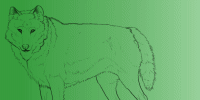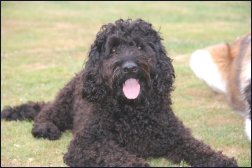|
  BY
INDECISIVE
BY
INDECISIVE
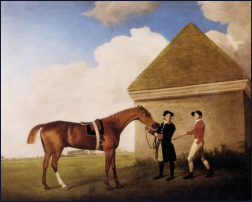 A JHOL
STUBBS PAINTING OF ECLIPSE
A JHOL
STUBBS PAINTING OF ECLIPSE
Eclipse won all his races by some distance which made his
jockey
remark "Eclipse first, the rest nowhere." He was a fiery chestnut with
a white face right hind leg. Sired by Marske out of a Regulus mare
called Spiletta, he was bred by the HRH Duke of Cumberland at his
Cranbourne Lodge Stud. He was foaled during the total eclipse of 1764,
and his temprament was known to be highly-strung and boisterous.
Eclipse was the only racehorse to carry 12 stone in weight and be
unbeaten in all of his handicaps. In fact throughout his racing career
the stallion was unbeaten, before being retired to stud in 1770. It was
not uncommon for him to win his races by 10-20 furlongs. In those days
flat races were much further than they are on modernrace-tracks.
Eventually his owner retired him to stud because of the lack of
competition. Eclipse died of colic is 1789 at 25 years old. At the time
of his death, he had become such a well-known racehorse and sire that
it warranted a search of his body and skeleton to find out as much as
possible. 
Eclipse’s decendants are
around 80% of the
thoroughbred racehorses including Kauto Star and Desert Orchid.
Scientists have examined Hermit’s origins by taking a sample
of
DNA from one of eclipses teeth to see if hermit is a decendant of
eclipse. This research will help to decode the genetic information of
great racehorses.
Research carried out by scientists from
the royal
vetinary college and the university of cambridge, is helping to figure
out the gentic origins of the thoroughbred racing stock worldwide. The
research is also helping to find the answer to why Eclipse was such a
great undefeated champion of 18th century.
Tests have also been carried out on
1867 Derby
winner, Hermit. Equine science aims to understand what makes horses
able to catch diseases easier and are more likely to break down during
training. Research shows that by tracing the lines of modern day
racehorses you will find very small groups of animals that were
imported from the Near East and North africa in the early 18th century.
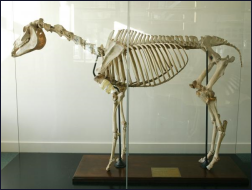 BONE
STRUCTURE OF ECLIPSE
BONE
STRUCTURE OF ECLIPSE
The work of the RVC is to further
discover which
genetic traits have been inherited through the 30 or more generations
since the foundation stock. Experts have used CT scans of
Eclipse’s skeleton and reports of his races to create
computer
models of his structure. Using portraits researchers have been able to
reconstruct one of his legs and have discovered that his legendary
speed was due to his overly average’ body. A successfull
racehorse must not only be quick footed but also very avaerage. For a
racehorse to be very fast it needs the ability to bring its legs
forward quickly, which is difficult for the larger horses with longer
legs. Eclipse was smaller than the modern racehorse and was therefore
more average in the breed’s range giving him his incredible
speed.
A horses leg may be refered to as a
pogo stick
because it uses stored energy in the muscles and tendons to propel the
animal forwards and upwards. Research has shown that horses with
stiffer legs restrict how quickly they can transmit the force to the
ground and bounce back up again, therefore reducing the speed in which
the animal can move. Stiffness in the leg also makes the animal more
prone to injury.
The tests that were conducted by the
structure and
motion labratory answers questions about the movement of many other
animals and further research may lead to the knowledge to design robots
with more stability which will help us with understanding how dinosaurs
walked.
BY
HORSE-FROG-PICKLE
VirtualPups is a large multi-player
game. It
involves strategy, and you choose how you play the game. There are many
assets to VP, such as breeding, training, trading (buying/selling
dogs), competing, gambling, as well as a large friendly community. The
community plays a huge role in the game, you will continually interact
with other players whether it be your competing against them, you sell
or buy a dog to them, or even having a conversation with them. 
With the forums and the chat it makes
it easy to
interact and have a great time meeting some new friends. This amazing
game has endless possibilities of how to play. Some players choose to
strive to improve the stars and the stats on a certain breed, while
others choose to find the perfect show dog.
Sponsor kennels then assist you to
become extremely
successful, (Not that you can't be successful as a novice, a free
account.) And there are many sponsor types, which would include:
Training, Rescue, Breeding, Prestige and Boarding. Sponsor accounts are
$25 USD (United States Currency) and last one whole year, giving you
many perks.
With an upgraded account, some of the
features
include: Unlimited turns, unlimited breeding, up to 10 additional
novice accounts, an unlimited number of dogs, 20 unmade imports, and
you may host 4 events a day.
Other goodies you could purchase with
USD are;
Custom Dyes for $9.00 (You get to choose the color of your dog), 20
unmade import dogs $6 (These are dogs with no lineage that you can
choose the breed and gender of, although your account must be upgraded
to order these), and lastly you can create your very own breed of your
choice! This is is a bit more pricey, costing $95 USD and $50 of this
transaction is donated to an animal shelter called Life Long Friends:
http://www.lifelongfriends.org/.
With over 200 breeds of dogs to choose
from, your
experience on VirtualPups is entirely up to you, you can work toward
goals all the time continuously improving along with having a great
time!
 BY
DRAGONWINGS
BY
DRAGONWINGS
Like everyone
else, there
are times when I need to do laundry. I hate doing laundry. I'm known
for washing all of my bras and undies at once, and then spending an
hour unraveling the undie ball that I remove from the dryer. The dryer
is also known for housing Matinga Boobert, the overlord of the dryer
who steals my socks. I could put a single sock in the dryer, and by the
time its done drying the sock will be gone.
Well, my couch cover
had had an unfortunate incident with a bowl of spilt pea soup, so I
decided to just do all of my stuff at the laundromat, because it would
be easier. Its a big couch cover.
SO I loaded everything in the Blazer,
and off I
went.
Got
to the place, which was actually a really nice one, well lit, nice
people. Started 3 loads; the couch cover and some sheets, a load of
jeans 7 t shirts, and a load of socks, undies, you know, the normal
things one washes.
I was reading my Robyn Young book, so
as soon as
everything was done I swapped it over, and kept reading.
Nothing exciting.
When the stuff was dry I went out to my
car to get
another laundry bag thingie, and went back inside.
Took
out the cover and sheets, got them folded, talked to a cute lil old
lady who was telling be about how she grows the prettiest roses. Went
through, folded jeans and t shirts, put them in the hamper. Artfully
dodged a kid pushing a laundry cart around the place.
Then I opened up the 3rd dryer, grabbed
the socks
and a bra out....and stopped.
Where the hell were my underwear?!?!?!?!
I closed the dryer door and opened it
again,
thinking they would magically appear. But nothing.
So
I looked around, and asked the little old rose lady if anyone had
gotten anything out of the dryer, and she said she hadnt seen
anyone...and she had been right there so she would have known.
7-10 pairs of underwear...gone.
Now, I know what you're thinking.
Dragon, you're a
flake, you prolly didnt even bring any to wash.
No.
I did. Because one of the pairs had Jack Skellington on them, and when
I tossed them in the wash I started singing, "Whats this? Whats this?
There's laundry everywhere...whats this, theres panties in the air,
whats this, I cant believe my eyes, I must be dreaming, wake up Draggy
this isnt fair!" until the owner of the place gave me a look.
Aparrently laundrymat owners are not musical people.
My NBC
undies with Jack's smiling face on the toosh. My tic tac toe boy cuts.
My yellow thong with flamingos on it. Gone. My Cheshire cat striped
ones, my Oscar the Grouch bikinis. They were all gone.
Gone.
Now,
I wont even allow myself to think about the type of person who steals
someones underwear. But still. Why MY underwear. Maybe they were Disney
fans or loved Sesame Street. WHo knows.
I just remember dragging
my laundry bag into my car, a remorseful tear in my eye as I tried to
remember where I ordered my Oscar the Grouch undies from.
Somewhere, the rival of Matinga Boobert
is
relishing their victory and dancing around in my chonies.
I will get my revenge!
DRAGON WE THINK THE
BUNNIES DID IT

|
 BY KHOLRAN
BY KHOLRAN
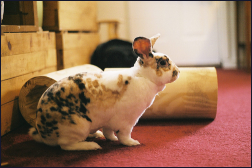 PHOTO
BY CARLEY & ART
PHOTO
BY CARLEY & ART
The Easter
season brings with it certain symbols: brightly colored eggs, baskets
full of chocolate, fluffy yellow chicks, and, perhaps the most
recognizable, the rabbit. For some, bringing home a real rabbit for the
kids on Easter morning is a temptation too hard to resist. As with any
pet, however, some important decisions need to be made before a cute
fluffy bunny is added to the family. They are neither easy nor
‘throw away’ pets as many believe, and they can be
quite
expensive and time consuming. What other misconceptions might there be?
Despite the fact that rabbits have been domesticated for well over
1,000 years, behavior, needs, and proper care were not sufficiently
studied until quite recently. As a result, much of the information that
does exist, both in print and out there on the internet, is outdated
and on occasion downright inaccurate. So what, then, is a rabbit owner
to do when it comes to basic care? Luckily, the rabbit is starting to
gain equal footing with dogs and cats as a household pet, and accurate
information is much easier to find.
Rabbit Basics
Rabbits belong to the scientific Order
of animals
known as Lagomorphs, and are not rodents as many people believe. Close
rabbit relatives include hares and pikas. While they do bear
resemblance to rodents, lagomorphs can be recognized by their distinct
second set of incisors (sometimes called peg teeth) on the top jaw.
Rabbits are herbivores, and can, with proper care, live for an average
of 8-12 years. They range in size from Dwarves to Flemish Giants, with
the smaller breeds being much more energetic, and each individual has
his or her own distinct personality.
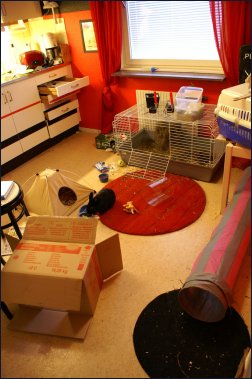 SMALL
CAGE IS FINE AS LONG AS THERE IS PLEANTY OF EXCERSIZE
(if
you leave the door open however make sure to pad it)
SMALL
CAGE IS FINE AS LONG AS THERE IS PLEANTY OF EXCERSIZE
(if
you leave the door open however make sure to pad it)
Housing
Housing is perhaps one of the largest
debates when
it comes to proper rabbit care. Many rabbit owners are content to leave
them as outdoor pets, while others would never consider it. On average,
outdoor rabbits do have a shorter lifespan. Being prey animals, they
are very easily stressed, and are highly susceptible to changes in
temperature. Predators pose the largest risk to a rabbit housed
outdoors. Coyotes, raccoons, owls, hawks, cats, and dogs are only some
of the animals that pose a threat to a rabbit- and because of their
very acute senses of hearing and smell, a caged rabbit can stress
itself to death without ever laying eyes on the predator. Many rabbits
also suffer physically and behaviorally from lack of socialization,
handling, and exercise. Risk from parasites and disease is greatly
increased outdoors, and given that rabbits often hide symptoms of
illness, by the time their owners realize there is a problem, it is
often too late.
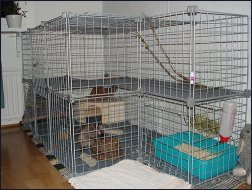 ANOTHER
GREAT EXAMPLE OF A INEXPENSIVE AND EASY TO PUT-TOGETHER CAGE
ANOTHER
GREAT EXAMPLE OF A INEXPENSIVE AND EASY TO PUT-TOGETHER CAGE
Whether
the rabbit lives indoors or out, it is likely that they will need to
spend time in a cage. There are many types of cages available, however
not all cages marketed to rabbits are really appropriate for them. Size
does matter! When it comes to rabbit cages, the bigger the cage, the
happier the rabbit will be. At the very least, the cage needs to be
four times the size of the rabbit, which means that a dwarf rabbit is
going to be able to inhabit a much smaller cage than a giant. Flooring
is another very important aspect of a rabbit’s environment.
Because rabbits lack paw pads like cats or dogs, they |
should
never ever
be kept in a cage with a wire floor. Wire flooring is the leading cause
of ulcerative pododermatitis, also known as “bumble
foot”,
which
creates painful and sometimes crippling sores on the feet. Be cautious
to avoid dusty floor materials, though. Pine shavings, cedar, and kitty
litter are three commonly used items that should be avoided at all
costs. Not only are these items dusty and irritating to the eyes and
nose, they can prove toxic if ingested.
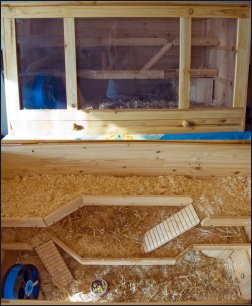 WOODEN
CAGES REQUIRE LOTS OF MATIENCE, AND THEY ABSORB ODERS AS WELL AS URINE
WOODEN
CAGES REQUIRE LOTS OF MATIENCE, AND THEY ABSORB ODERS AS WELL AS URINE
Diet
Perhaps the most important aspect of
rabbit
ownership is what to
feed the rabbit. Popular culture has created the image of the rabbit
eating carrots, while pet stores promote a pellet diet. It might
surprise owners to know that neither one is an appropriate diet. The
most vital part of a pet rabbit’s diet is roughage. They
should
have
constant access to a good quality Timothy or Grass hay (Alfalfa, while
good for newly weaned babies, is too high in calcium for an adult
rabbit and can create bladder crystals). Like horses, a
rabbit’s
gut
needs to be in constant motion, or the risk of blockage or bacterial
infection is greatly increased. Store-bought pellets can supplement the
diet and provide necessary fats and proteins, but should never make up
the majority of it. The average rabbit (5-7 lbs) should be fed no more
than ¼ cup of pellets per day. Use caution with the type of
pellets as
well- many companies will mix brightly colored bits and pieces into the
pellet diet, which do nothing but add unnecessary sugar to the
rabbit’s
body. A good pellet should be high in fiber and lacking in any
additives.
Along with hay and limited pellets,
fresh
vegetables are an
important part of any rabbit’s diet. Dark, leafy greens, such
as
parsley, romaine lettuce, and collard greens are best, and while
moderation is key with any veggies high in sugar (like carrots), a
rabbit should get at least two or three different greens per day to
vary the diet.
Other Concerns
While where to keep the rabbit and what
to feed it
are two of the
most important things to consider, there are many other factors that
contribute to whether or not a rabbit is right for the family. Indoor
or outdoor, a rabbit should be given a bare minimum of 2-3 hours of
exercise out of the cage daily. In an extremely busy household, this
necessary activity may be too time consuming. Preparing to let the
rabbit exercise can be equally as time consuming. Rabbits are born
chewers and diggers, and therefore their environments must be
absolutely free of any harmful items (such as cords and wires) as well
as anything an owner might not want to have chewed (baseboards, carpet
edges, sofa corners, chairs and piano legs to name a few). Another
thing to keep in mind is that rabbits can be messy. With a bit of time
and patience, a pet rabbit can be trained to use a litter box- however
in most cases “litter trained” translates to
“urinates in the box
consistently”. Because rabbits are constantly eating, they
are
also
constantly dropping pellets, and cannot be expected to place every
single one in the litter box, regardless of training. Finally there is
the potential problem of finding a suitable (and qualified!) vet. Due
to the lack of sufficient information regarding rabbit physiology, many
veterinary programs provide vets far less training with rabbits than
with cats or dogs. As a result, while most small animal vets will see a
rabbit, an exotics vet or rabbit specialist is a much better choice for
both routine care and emergency medical services. Like cats or dogs,
rabbits do need to see a veterinarian at least once a year. While they
do not get vaccinations in most places, routine checkups are a vital
part of ensuring a long and healthy life for the rabbit.
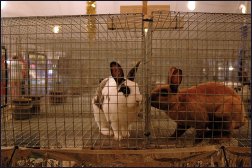 LACK
OF PADDING AND SPACE TO MOVE IS DESTRUCTIVE TO THE ANIMAL BOTH MENTALLY
AND PHYSICALLY
LACK
OF PADDING AND SPACE TO MOVE IS DESTRUCTIVE TO THE ANIMAL BOTH MENTALLY
AND PHYSICALLY
Despite
the common misconceptions that rabbits are simple,
short-term pets that require very little in the way of care, they are
quite complex animals. Each individual is different, much as each cat
or dog is different. There are lap rabbits and aloof rabbits, lazy
rabbits and hyperactive rabbits. They make excellent household
companions for those willing to put in the time to care for them
properly. This Easter, make an informed decision. If a 10 year
commitment is too much, then stick to rabbits that are either plush or
made out of chocolate.
Please visit http://rabbit.org
for additional care tips, and support http://www.makeminechocolate.org
this Easter!  |
 BY
BRITTSY
BY
BRITTSY
Calling all virtualpups citizens! I, Brittsy, am
here to
teach you (yes you!) the ropes of responsible breeding on the
oh-so-famous virtualpups site. This step-by-step guide will surely help
you get started on your career as a reputable breeder.
Step One
– Always have the end in Mind
As the title states, you should always
have the end
in mind. And what exactly do I mean by this so very knowledgeable
declaration, you ask?
You should have a good idea beforehand
of what you
wish to accomplish. There are four popular, standard goals when
breeding that you should be familiar with.
Stars: The breeding of canines to raise
the stars
to x4 beside each of the ten characteristics on the main page.
Showing Benefits: The breeding of
canines that hold
specific stats to enhance the number displayed next to a certain
characteristic.
Profit: To purchase a pair of current
highest-starred dogs, or several stars below, of a particular breed.
These canines are bred to one another after being 280/200 trained to
increase the chances of high-starred offspring. The good-quality litter
is sold to the public for a decent price.
Lines for Stars: To create a personal
bloodline by
acquiring 8 or more “Imports” (Parentless Canines)
from a
sponsor player. Each pair should be marked as (Insert-Name-Here) A, B,
C, ect. The trained dogs that have the same letter are bred to one
another, and one of each gender is kept, named, trained and bred.
Step Two
– So many choices, but what to choose?
After selecting one of the four
customary goals, it
is time to choose which breed you will be specializing in. I agree, it
is easy to say “I like Border Collies! Let’s breed
em’!” but that is not always the case. Remember to
reflect
on step one. Ask yourself these simple questions that will definitely
help you in the long run.
What is my main goal? - Stars, Showing
Benefits,
Profit, Lines?
Which Group do I wish to work in? -
Herding, Hound,
Working, Terrier, Sporting, Non-Sporting, Toy, Feral?
Do I have a sufficient amount of money
to do this?
- Keep in mind, Lines (from scratch) cost around 10-15 million dollars,
the price rising mostly for Toy breeds & dogs with
exceptionally
low stats. Breeding for Showing Benefits may also become expensive if
you choose to work with a less common breed. How hard do I want to
work? (Low, Moderate, High) - Dogs with low Average Stars (2 - ) will
take much more time to train and breed, especially if you are starting
a bloodline specifically for stars. Mixed bloodlines may also be hard
to work with if the dogs are of a rarer breed.
How popular is the potential breed? -
Visit the
considered breed’s main page to view the population number.
Check
out the number of “For Sale” and “For
Stud”
dogs, which will give you an idea of the breed’s VP fame.
Step Three
– Do this, do that…are you listening?
Training plays a huge part in your
ability to
produce better dogs and rack in the cash. But if your precious pooches
aren’t trained correctly, your money could drop drastically.
Herding – Discipline 100,
Working 100,
Sporting 80, Stats to 200, no aggression.
Working – Discipline 100,
Working 100,
Sporting 80, Stats to 200 w/ Aggression
Hound – Discipline 100,
Working 100, Sporting
80, Stats to 200, Agg. Optional
Terrier – Discipline 100,
-choose depending
on field you wish to show in-
Sporting – Discipline 100,
Sporting 100,
Working 80, Stats to 200, Aggression Optional
Non-Sporting – Discipline
100, Show 100,
Work/Sport 80, Stats 200, Aggression Optional
Toy – Discipline 100,
--choose depending on
field you wish to show in-
Feral – Discipline 100,
Working 100, Sport
80, Stats to 200 w/ Aggression
These are the preferred training
styles; however
you might just find your dog successful in other ways. When working on
Lines for Stars, many do not train their dog 280, as it will not be
used for eventing. Nevertheless, stats are brought to 200, aggression
250, and groomed until a few years before death.
I hope this training guide aided in you
in one way
or another. =D
Peace out,
Brittsy <333
|
|
 BY
JNFERRIGNO
BY
JNFERRIGNO
The last two months has had the canine community
buzzing,
eager to know who and what the first dog would be. History shows us
that a single dog has the potential to make or break a presidential
candidate. That said, a President also has the capability of making or
breaking a breed.
While it is said that Fala, the black
Scottish
Terrier of President Franklin D. Roosevelt, secured him a fourth term
in office; Roosevelt inadvertedly quadrupled the popularity of the
breed. Just the same, in the 90’s Clinton made the Chocolate
Labrador popular, and now as a result Lab supporters try to avoid
breeding these dogs due to the negative health effects triggered by
their growing demand. Richard Nixon is said to have destroyed the
Cocker Spaniel overnight. The proof of Nixon’s influence can
be
seen in the top 10 most aggressive dog breeds list. Cocker Spaniels
often suffer from a genetic disorder known as rage syndrome, which
causes them not only to attack strangers but turn on their family
members. Lyndon B. Johnson loved all three of his Beagles; however they
now are one of the most common breeds found in rescue shelters.
"LABRADOODLE" BY STEPHEN
WITHERDEN
It never fails, that after announcing
the next
Presidential dog, breeders must then contend with the influx of demand
for said breed. For breeds with such a limited gene pool in North
America, like the Portuguese Water Dog the Obama’s are said
to be
rescuing in the spring, this spot-light effect can have severe
consequences. President Obama announced that there were a few things to
consider before finally choosing.
The main thing to consider was his
daughter’s |
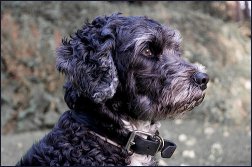 PORTUGUESE
WATER DOG BY HALLOW INDUSTRIES
PORTUGUESE
WATER DOG BY HALLOW INDUSTRIES
allergies, which for that
there are no true hypo-allergic dog breeds. Celebrities, Breeders, and
the AKC, have all been pushing various hairless and curly coated types,
but President Obama made a comment to the press that he wished to adopt
a mutt from a shelter, which then created a huge amount of public
support. However when their final selection came down to either a
designer breed like the Labradoodle, or the recognized Portuguese Water
Dog, Obama’s wife favored the later.
The problem here is that it is
extremely rare for
there to be any
PWD’s to rescue, especially at the puppy age. Portuguese
Water
Dog’s
are not that common in North America, and as a result almost always
lead out the rest of their lives with their original family. Due to the
families’ decision against a mutt and the decreasing chance
of a
shelter animal finding a good home, the once supportive community has
now taken a turn toward disappointment.
“The gene pool is so small
that the next
thing you know you have
unscrupulous breeders that can ruin the breed,” says
Lesley-Ray
Karnes,
during an interview by the Dog Channel. Karnes is one of the top
retriever trainers in the U.S. and has worked with these dogs before,
“They’re wonderful dogs, but there aren’t
many of
them.” Portuguese
Water Dog lovers are worried that the PWD will be added to the list of
breeds ruined by the Presidential spot light. Others say if it
isn’t
the PWD it will be another breed. The media is pressing for a final
decision, but what matters is that the Obama’s find a dog
which
suits
their family, "This has been tougher than finding a commerce
secretary,'' Obama noted. |
|
 
|
|



























